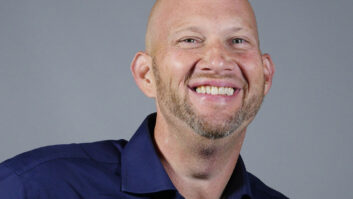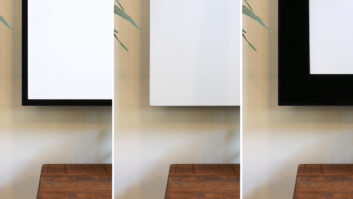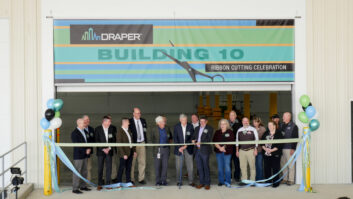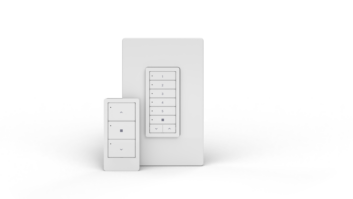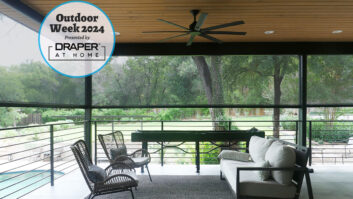
Posing outside their surprising large Spiceland, Indiana, headquarters are Draper’s advertising manager Penny Sitler and home theater sales manager Bob Hadsell.
There’s a small town Indiana projection screen manufacturer that put the name “Draper” on the map well before a television series called Mad Men went on a run of four straight best drama Emmy wins, with a womanizing adman named Don Draper as the lead character.
Don Draper may be struggling to regain his mojo following an ugly divorce, but Spiceland, Indiana’s Draper is still quietly going strong after almost 100 years thanks to a diverse product range that goes well beyond just projection screens.
During a visit to the company’s headquarters about 35 minutes east of Indianapolis, I learned that not only has Draper been around since 1902, when it was founded as a school shades supplier by Luther Draper, but I also discovered that the company basically owns the basketball “backstop” market with its EZ Fold products. Go figure, there are even Draper backstops in Duke University’s Cameron Indoor Stadium.
The company, which supplies a much higher percentage of projection screens to the commercial channel than to home theaters, still sells window shades in great numbers, albeit much more sophisticated offerings than it probably did in 1902. And the company has grown to 500-plus employees, with Luther Draper’s descendents still at the helm.
I’ll admit to not knowing all that much about Draper’s FlexShade Systems before my visit, but I’ve gained a whole new respect for the company’s product line and now consider it a major player in the window shades business. I also learned a great deal more about Draper’s video lifts and mounts, which are mechanical products that I saw being fully tested right there in the company’s massive warehouse (they actually use their own lifts to hold up the lifts that they are test; pretty funny.)
I was surprised to learn that Draper does not manufacturer its own projection screen fabrics, but “sources” them to spec. Instead, the company’s employees spend their time running machines that cut the fabric to appropriate sizes, and assembling the pieces that make up manual and automatic screen products and painting the borders on the pulldown screens, attaching tab-tensioning wires, etc. Special tools make these processes less laborious than a few years ago, but there’s still a lot of manual work involved.
Like many screens manufacturers, Draper also has its own “art for flatscreens” offering, but theirs is a little different. Instead of a faux painting that rolls into a gilded frame around the LCD, Draper partners with a textile company in North Carolina to create actual woven tapestries based on either a library of images or a client’s personal photo, custom graphic, or corporate logo. I’m pretty sure it’s the same company that created a blanket with my daughter’s picture on it.
But it’s home theater screens that I was most interested in, and I felt right at home (pun intended) talking to residential AV/home theater sales manager Bob Hadsell. He told me that while he feels like residential could always be a bigger focus for the very commercially oriented Draper, the company is very successful with it current mix of commercial screens, window shades (resi and commercial), and basketball backstops, making it tough to re-allocate resources to home theater at times.
That, and a slightly more conservative Midwest sensibility perhaps, have meant that Draper is a little slower to bring a 3D screen solution to market for home theater. I was told that until better 3D testing equipment is available, creating a screen for the developing technology was literally a shot in the dark. Hadsell said that projector manufacturers haven’t really been able to verbalize what it is that they need for their 3D products.
I noted on my factory tour (sorry, no photos allowed) that the company didn’t seem to be created any perforated screens. That’s when I learned another surprising detail: Draper sells acoustically transparent woven screens, which is a feature I thought was pretty exclusive to another couple of much more expensive vendors.
A couple of other fun facts before I get back to CEDIA EXPO planning: Draper is very green, with several of its management team owning LEED certifications and very low-waste manufacturing and shipping processes. Also, the company is very employee friendly. In fact, I was told that Draper has never laid off an employee in all of its years in business (even during the Great Depression) and runs a medical clinic (in partnership with a local hospital) to treat basic aches and pains of its employees for free.
I love when I find out that there’s more than meets the eye with a company. Now if Don Draper could just get his mojo back…

